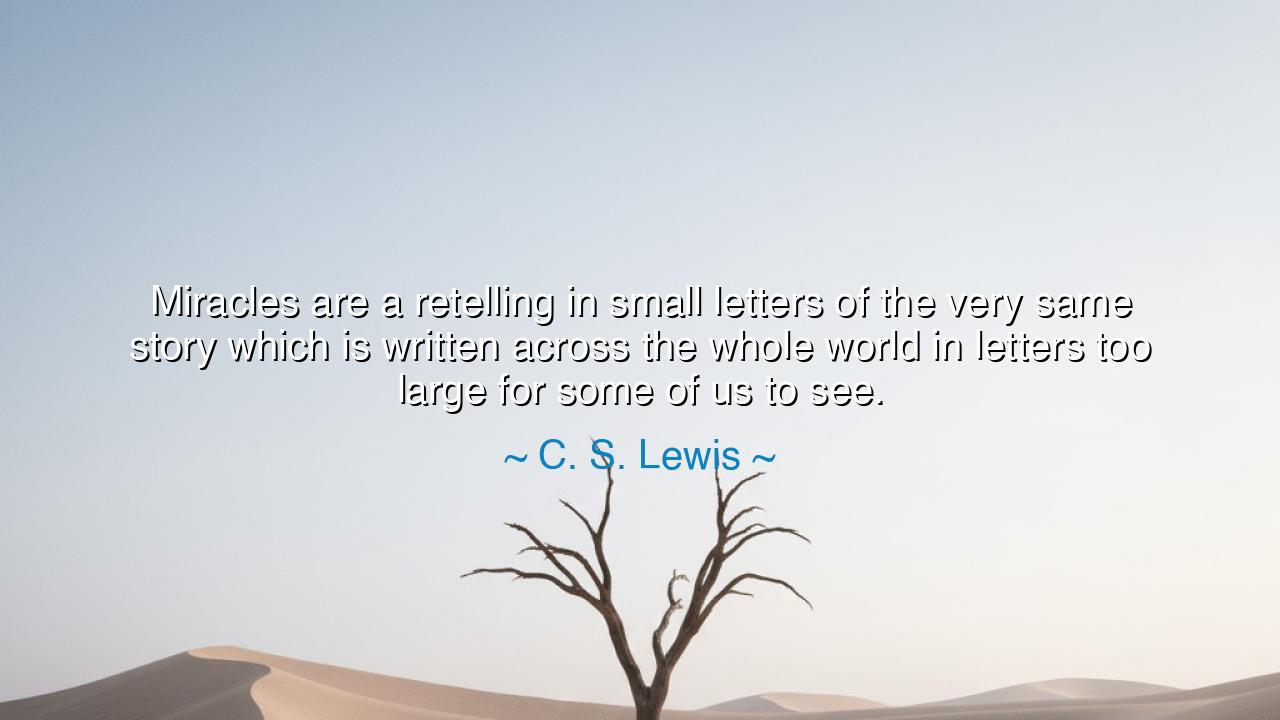
Miracles are a retelling in small letters of the very same story
Miracles are a retelling in small letters of the very same story which is written across the whole world in letters too large for some of us to see.






“Miracles are a retelling in small letters of the very same story which is written across the whole world in letters too large for some of us to see.” — so wrote C. S. Lewis, the philosopher-poet of faith and imagination. His words shine like a lantern in the fog, revealing that the wonders we call miracles are not interruptions in the natural order, but whispers of a divine pattern that has always been present — only too vast, too grand, for human eyes to fully perceive. Lewis reminds us that every miracle is but a smaller echo of a greater truth, a concentrated spark of the same fire that burns at the heart of creation itself.
In the style of the ancients, let us say: the world is a scroll written by the hand of the Eternal. Upon it are inscribed the laws of stars and rivers, the birth of life and the passing of time. But the writing is vast, and man — small as he is — cannot always read its sweeping lines. Thus, from time to time, the universe bends closer, and the divine hand writes in small letters — a healing, a revelation, a moment of grace — so that the eyes of the finite may behold what is infinite. These are the miracles: glimpses of the same truth that upholds the stars, told in a language the human heart can understand.
In his age, C. S. Lewis stood as a voice of reason and wonder intertwined. He lived in a time when many dismissed the miraculous as superstition — when the world sought logic without mystery, and science without soul. But Lewis, ever the seer between worlds, saw the unity of both. He understood that the miraculous is not a violation of nature, but a revelation of its deepest meaning. Just as a poet may write a single verse to express the heart of an epic, so too does the Creator express His boundless story in the small, sacred events we call miracles.
Consider the story of Florence Nightingale, who brought light into the darkness of war. Amid the cries of the wounded, she moved like a living miracle — a single flame against the endless night of suffering. To some, her compassion seemed almost superhuman, a divine intervention in human form. Yet in truth, she was retelling in small letters the story of mercy itself — the same mercy that beats in the rhythm of the world, that calls the sun to rise and hearts to heal. Her deeds were not apart from the great design; they were its reflection, made visible in the fragile hands of one woman who dared to care.
The meaning of Lewis’s words, then, is this: miracles are reminders. They are the windows through which eternity peers into time. When a storm calms, when a child is born, when forgiveness blooms where hatred once ruled — these are the same miracles that keep the cosmos turning, written now in a smaller script. They tell us that the divine is not far away, not confined to heavens unreachable, but pulsing quietly through every breath, every heartbeat, every moment of grace.
And yet, the tragedy of human life is that many walk blind through a world ablaze with wonder. We wait for great signs from the sky, not realizing that the whole world is already a miracle. The leaf unfolding, the tide returning, the soul choosing love over despair — these are the same miracles written in grand letters across creation. But we, who have grown dull with routine and noise, often fail to see them. Lewis urges us to awaken, to read again the living script of existence, to see the divine not in the extraordinary alone, but in the ordinary made holy by awareness.
So, child of dust and light, take this lesson: open your eyes to the small letters. Look not only for the thunderous signs, but for the quiet grace that moves through every hour. When you see kindness in a stranger, or strength rise from sorrow, recognize that you are witnessing the same story that moves the stars — the story of life, of love, of divine renewal. Do not dismiss the small as trivial, for within it lies the reflection of eternity.
For truly, as Lewis teaches, miracles are the language of God written in the dialect of man. They are reminders that this world — though veiled in shadow — is charged with meaning, alive with purpose, and radiant with the hidden fire of creation. To see them is to remember who we are: not wanderers in chaos, but readers of a sacred text, written in both heaven and earth, forever unfolding before our eyes.






AAdministratorAdministrator
Welcome, honored guests. Please leave a comment, we will respond soon